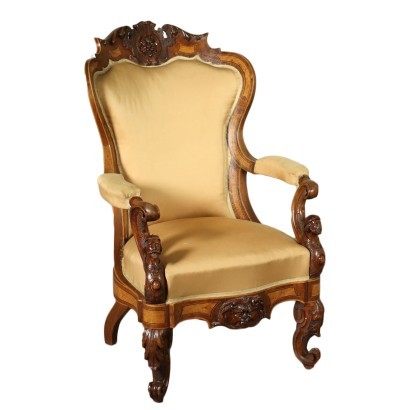Poltrona Umbertina
Features
Style: Umbertino (1870-1900)
Age: 19th Century / 1801 - 1900
Origin: Italy
Material: Padded
Description
Poltrona umbertina sorretta da gambe, delle quali quelle anteriori riccamente intagliate con motivi fogliacei e terminanti in piedi a ricciolo; la seduta e lo schienale sagomato sono imbottiti, mentre le parti in legno sono riccamente ornate. La fascia inferiore e il profilo dello schienale sono impiallacciati in radica con riserve in acero, presenti anche degli elaborati intagli in noce: un mascherone grottesco orna il centro della fascia inferiore, riproposto anche nella cimasina dello schienale; i montanti dei braccioli mossi sono intagliati a ricciolo e con due teste maschili a tutto tondo.
Product Condition:
Prodotto in discrete condizioni che mostra alcuni segni di usura.
Dimensions (cm):
Height: 110,5
Width: 71
Depth: 85
Seat height: 45
Additional Information
Style: Umbertino (1870-1900)
The name of this style is due to the ruler of the time Umberto I, appointed King of the Kingdom of Italy on 9 January 1878 and assassinated on 9 July 1900.The Umbertino style is typically Italian and belongs to that Eclectic period that characterized the second half of the 19th century, which lasted just under twenty years, the Umbertino style spread around 1880 and ended around 1895 when a new style called Liberty and universally known took over. like Art-Nouveau to be followed by Art-Decò.
In this style, mainly eclectic and monumental, Gothic and Baroque elements originally belonging to the Renaissance but also adorned with large masks, frames and decorations were re-proposed in the furniture, from the bedside table to the large wardrobe or sideboard.
Find out more about the Umbertine style with our insights:
An Umbertine secretary dedicated to Dante Alighieri
A comparison between a Luigi Filippo console and an Umbertina one




























